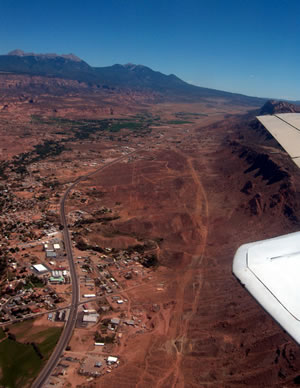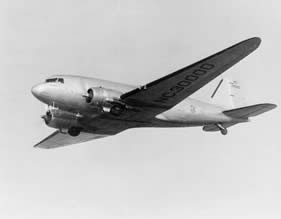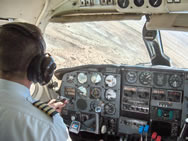A Short
History of Aviation
in Grand County
by Jeff
Richards
 Although
the Wright Brothers’ first flight took place over
a century ago, on Dec. 17, 1903 at Kitty Hawk, North
Carolina, many years passed before the full impact of
the achievement was realized.
Although
the Wright Brothers’ first flight took place over
a century ago, on Dec. 17, 1903 at Kitty Hawk, North
Carolina, many years passed before the full impact of
the achievement was realized.
The remarkable exploits of Wilbur and Orville Wright
were duly noted by major newspapers around the country
at the time, but they apparently did not attract the
attention of smaller rural newspapers such as Moab’s
own weekly Grand Valley Times (forerunner to today’s Times-Independent).
A computer database search of the Grand Valley Times issues from 1896-1922
indicates that the paper made no mention of airplanes or aircraft until
1914, the year that World War I began in Europe. In addition, Moab’s
first airport wasn’t built until the late 1940s, after the second
World War had ended.
Even so, a couple of native Moabites made aviation headlines in the
1920s. In 1927, Ida Larsen (later Ida Nichols) became the first woman
to take a commercial airplane flight from Utah when she rode in pilot
Jimmy James’ Douglas M-2 from Salt Lake City to Los Angeles.
The plane, a two seat aircraft with an open cockpit, was so noisy that
the only communication possible between pilot and passenger was via
written notes exchanged between them. Eventually, the late Mrs. Nichols’ notes
and her plane ticket were donated to a Western Airlines museum in Los
Angeles.
The other Moab aviator of note during the 1920s was J.J. Williams,
an Army lieutenant who was one of the so-called “Three Musketeers
of the Air” who performed in aerial race shows around the country
in the late 1920s (the other two members of the trio were Thad Johnson
of Celeste, Texas, and W. L. Cornelius of Antlers, Okla..) The trio
was based at the famed Selfridge Field in Michigan and toured with
Charles Lindberg around the United States and Canada. Williams was
killed during an air show in Los Angeles on Sept. 11, 1928, when his
plane crashed in front of the grandstand containing thousands of spectators.
Construction on Moab’s first airport began sometime around 1947.
The airport was located in Spanish Valley, about seven miles southeast
of Moab City. During the area’s uranium boom of the 1950s, airplanes
became a popular mode of travel, as well as a means of transporting
mining supplies around the rugged country. An article in the December
1956 issue of McCall’s magazine called Moab the “richest
town in the USA,” and noted that many of the town’s millionaires
had their own private planes (Moab reportedly had the second highest
airplane ownership per capita in the nation at the time). Pilot Dennis
Byrd, a close friend of Charlie Steen’s, took over management
of the airport in the mid-1950s.
 In
July of 1959, Frontier Airlines began daily service to Moab, flying
DC-3 aircraft to and from destinations such as Salt Lake, Denver, Albuquerque,
and Farmington, N.M.. Just over a decade later, a second airport was
built 18 miles northwest of Moab, and Frontier Airlines then reportedly
switched to Convair 580 aircraft. In 1974, Sun Valley Key Airline Company
took over the air service for Moab, and the air service contract has
since changed hands numerous times. Currently, Salmon Air operates
a dozen round-trip flights from Moab to Salt Lake City each week.
In
July of 1959, Frontier Airlines began daily service to Moab, flying
DC-3 aircraft to and from destinations such as Salt Lake, Denver, Albuquerque,
and Farmington, N.M.. Just over a decade later, a second airport was
built 18 miles northwest of Moab, and Frontier Airlines then reportedly
switched to Convair 580 aircraft. In 1974, Sun Valley Key Airline Company
took over the air service for Moab, and the air service contract has
since changed hands numerous times. Currently, Salmon Air operates
a dozen round-trip flights from Moab to Salt Lake City each week.
When the lease on the old airport in Spanish Valley expired around
1971, ownership of the land reverted back to the BLM and private owners.
The old hangar and the crumbling remains of the runway, with some three
dozen new homes in a nearby subdivision are all that remains of the
old airport today. The old airstrip was used for drag racing for awhile
in the early 1970s, but now the asphalt is in a severely deteriorated
condition.
Officially known as Canyonlands Field Airport (CNY), Moab’s current
airport is home to approximately 20 planes, and sees an average of
44 aircraft operations per day.


Another
noted aviator from Moab is Tim Martin, the “arch flying cowboy” who
flew his small plane through arches and rock formations
during the 1980s, before current restrictions against
such low-level flights were imposed. Although Martin
has long since retired from making such daring flights,
some of his daring flights have been preserved via remarkable
photographs and videos.

 Although
the Wright Brothers’ first flight took place over
a century ago, on Dec. 17, 1903 at Kitty Hawk, North
Carolina, many years passed before the full impact of
the achievement was realized.
Although
the Wright Brothers’ first flight took place over
a century ago, on Dec. 17, 1903 at Kitty Hawk, North
Carolina, many years passed before the full impact of
the achievement was realized. In
July of 1959, Frontier Airlines began daily service to Moab, flying
DC-3 aircraft to and from destinations such as Salt Lake, Denver, Albuquerque,
and Farmington, N.M.. Just over a decade later, a second airport was
built 18 miles northwest of Moab, and Frontier Airlines then reportedly
switched to Convair 580 aircraft. In 1974, Sun Valley Key Airline Company
took over the air service for Moab, and the air service contract has
since changed hands numerous times. Currently, Salmon Air operates
a dozen round-trip flights from Moab to Salt Lake City each week.
In
July of 1959, Frontier Airlines began daily service to Moab, flying
DC-3 aircraft to and from destinations such as Salt Lake, Denver, Albuquerque,
and Farmington, N.M.. Just over a decade later, a second airport was
built 18 miles northwest of Moab, and Frontier Airlines then reportedly
switched to Convair 580 aircraft. In 1974, Sun Valley Key Airline Company
took over the air service for Moab, and the air service contract has
since changed hands numerous times. Currently, Salmon Air operates
a dozen round-trip flights from Moab to Salt Lake City each week.
